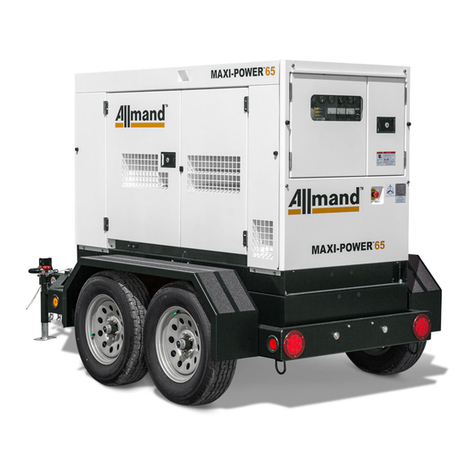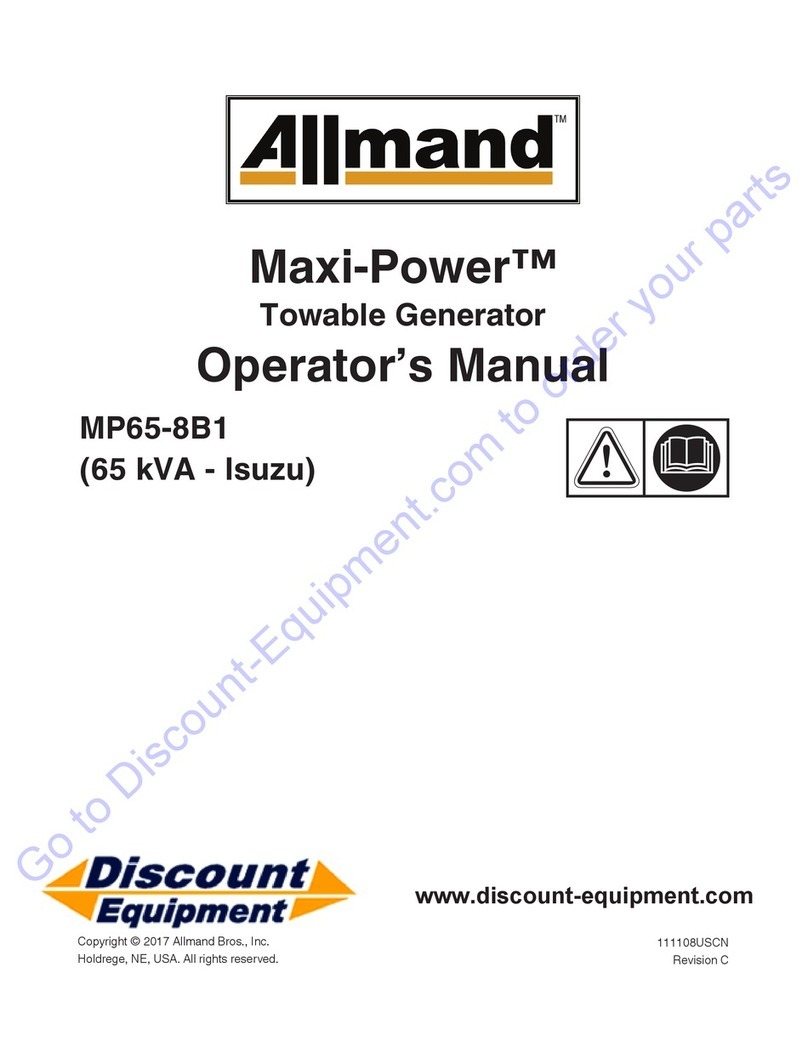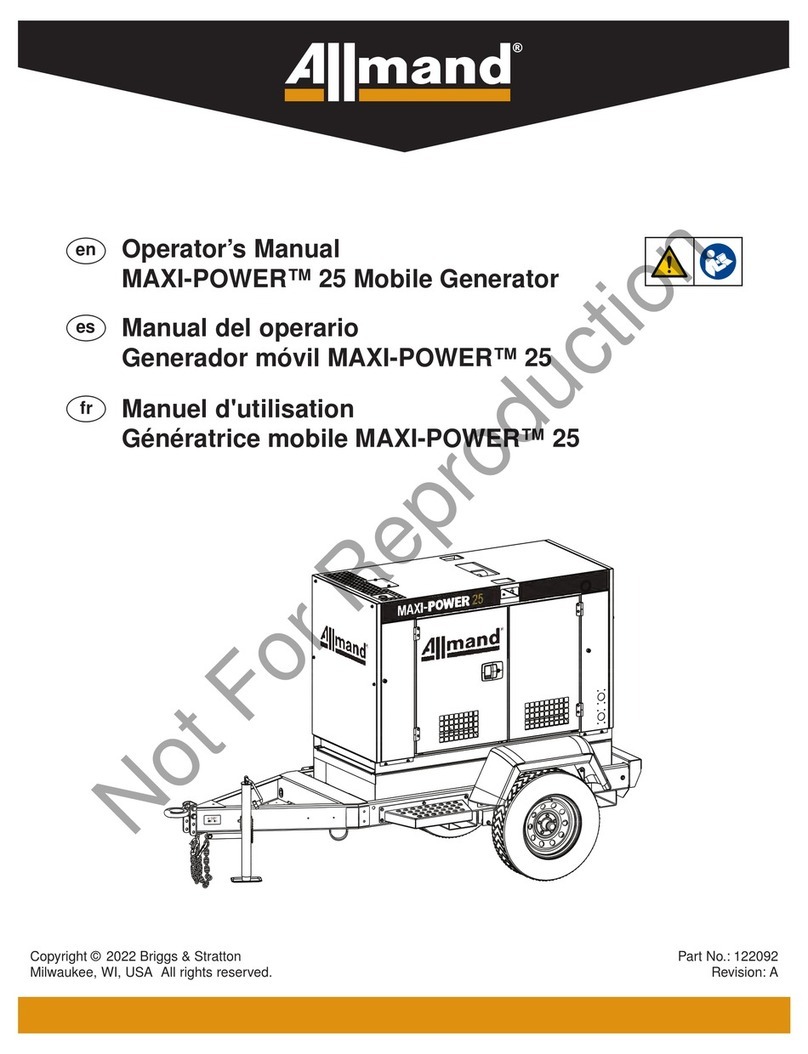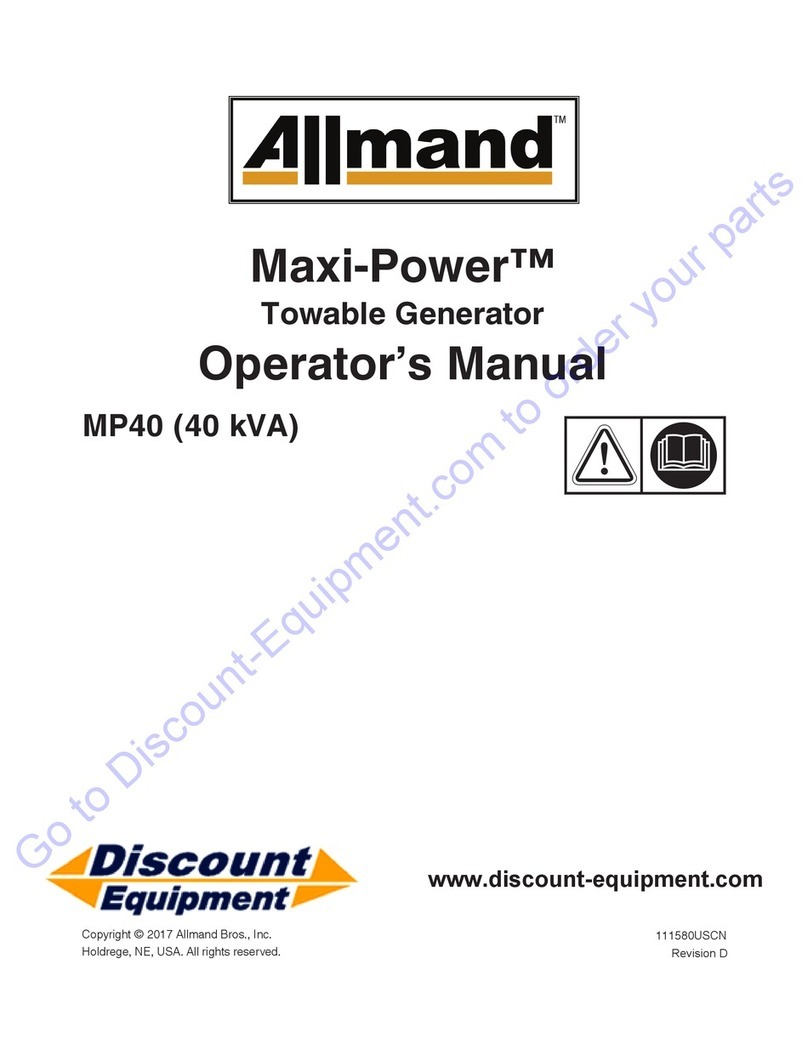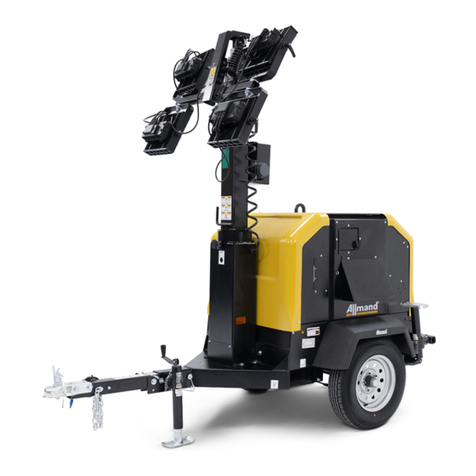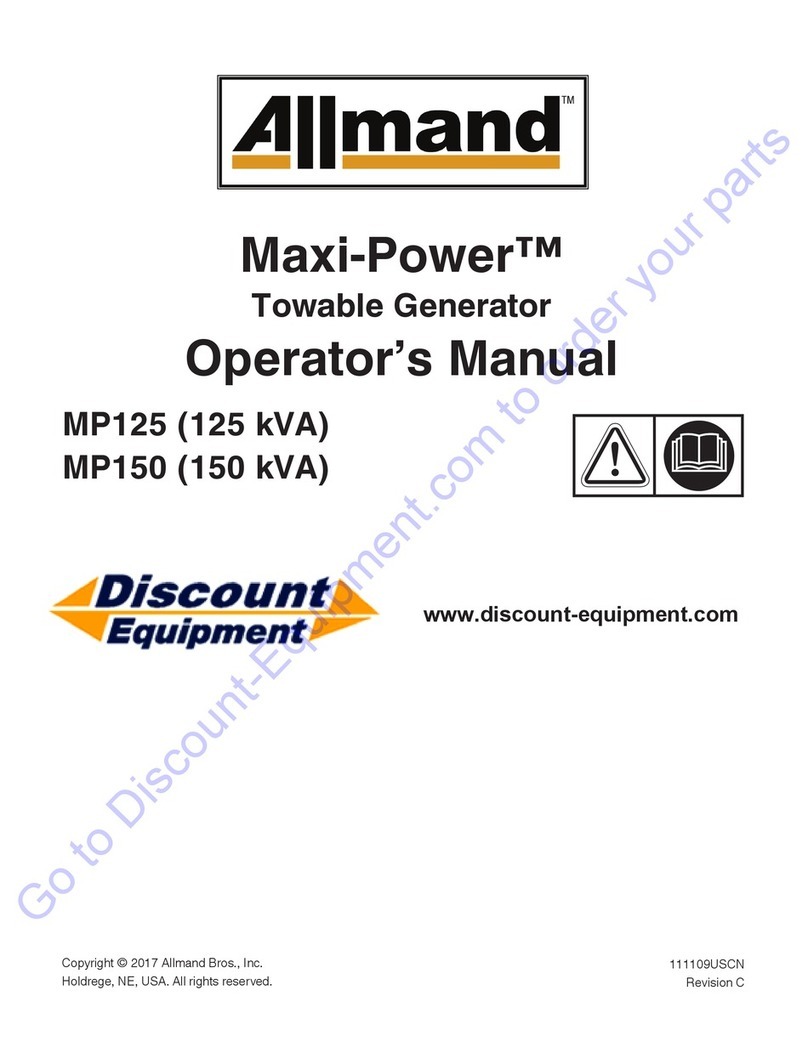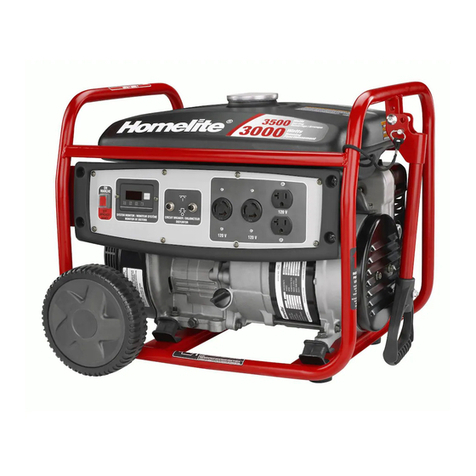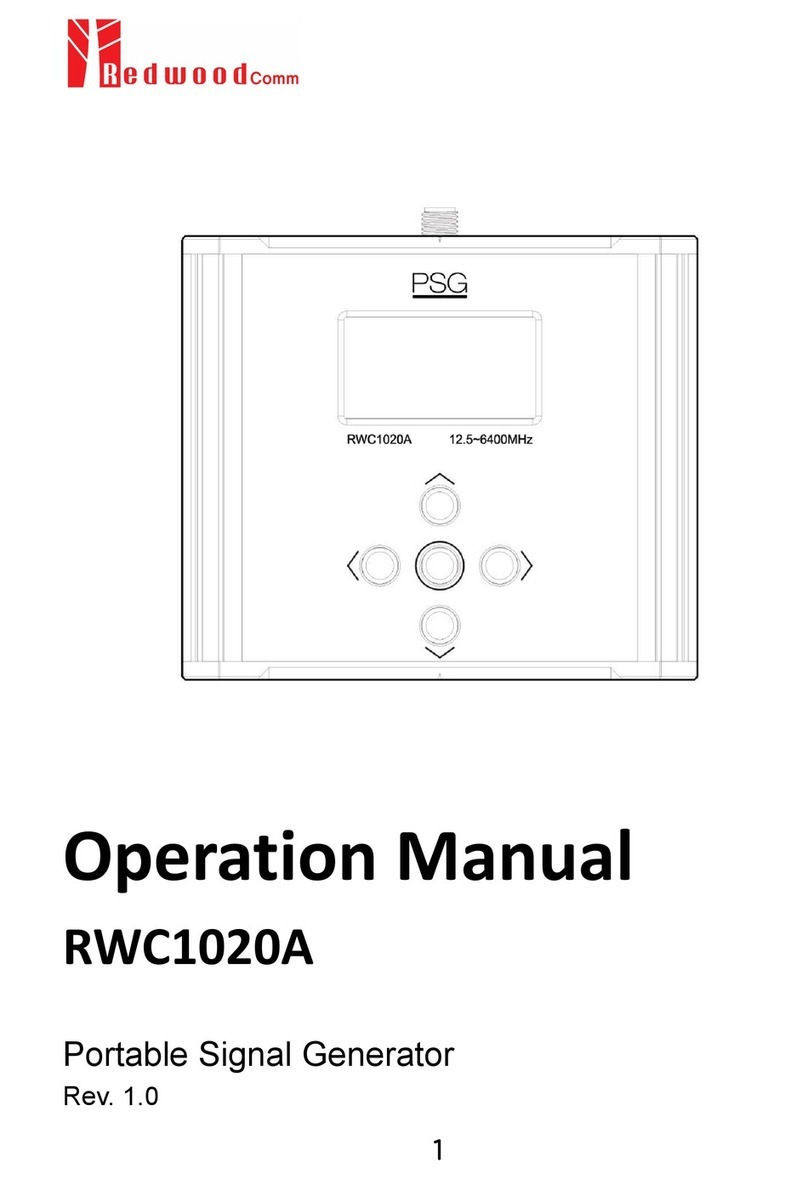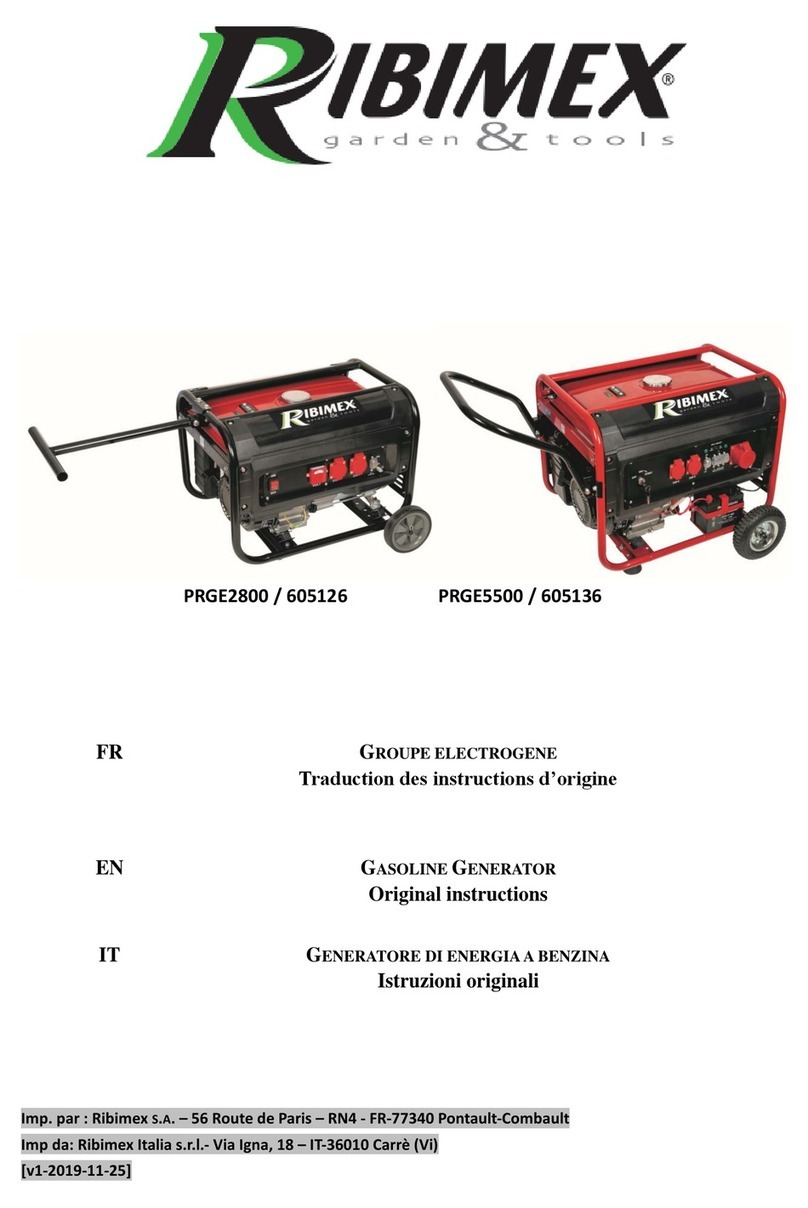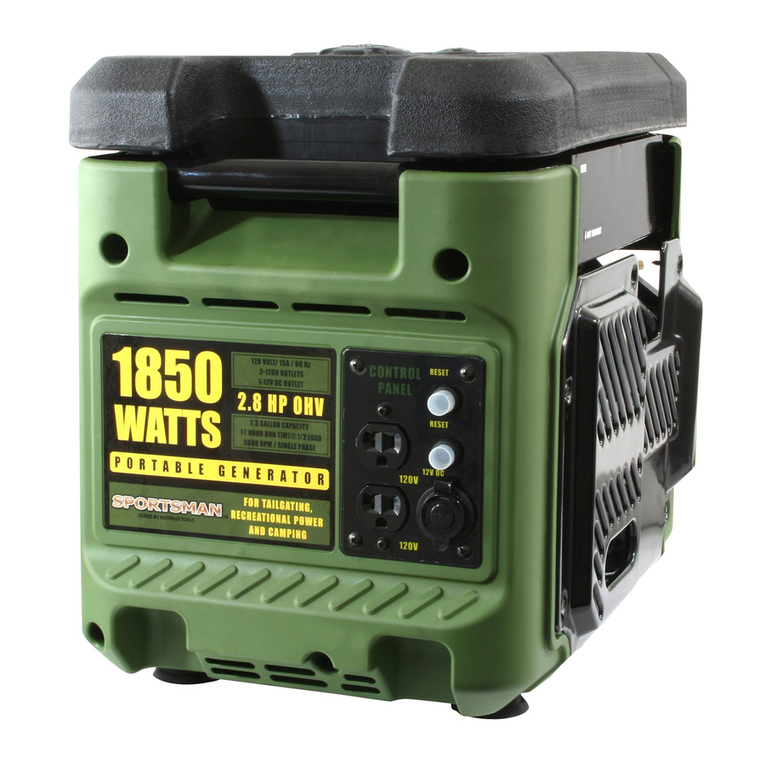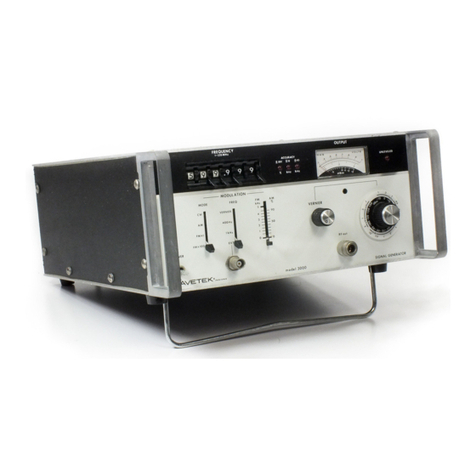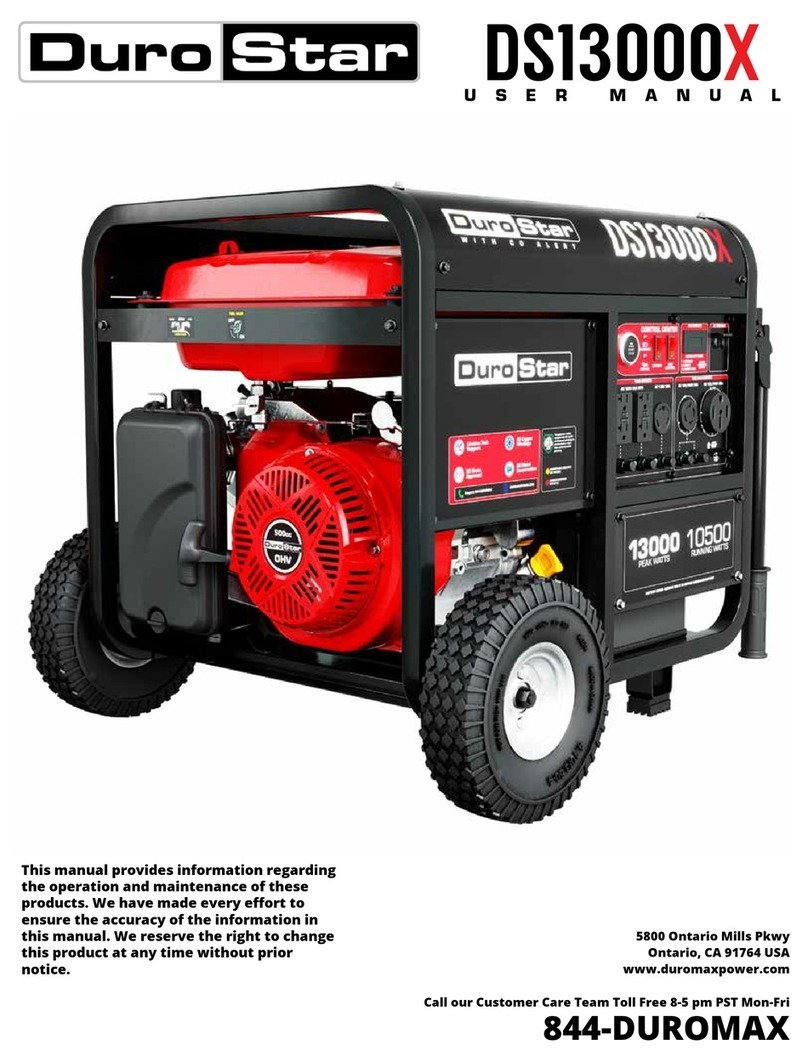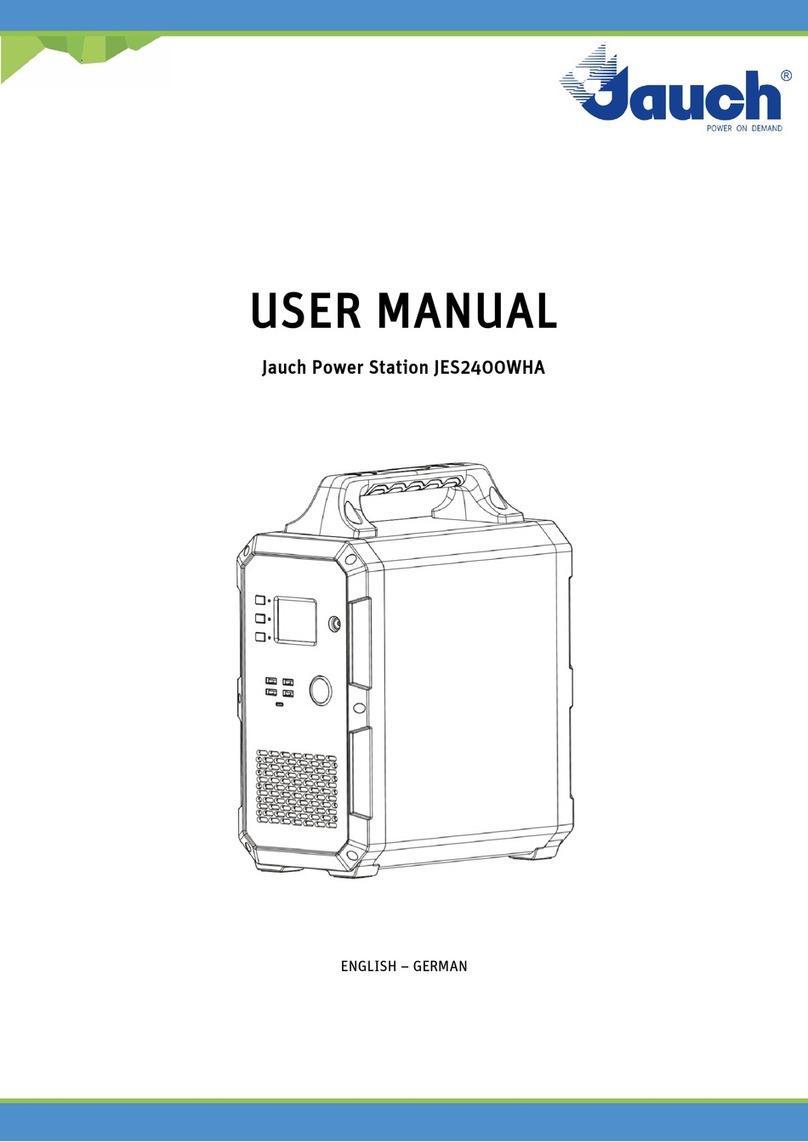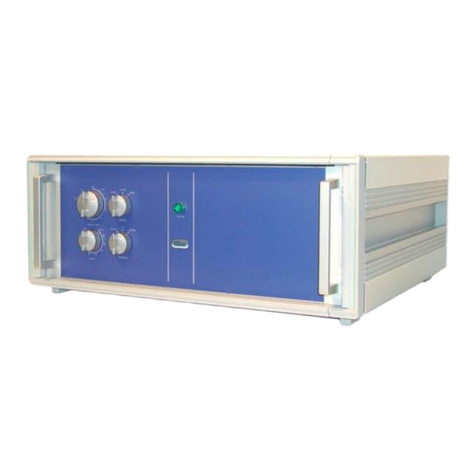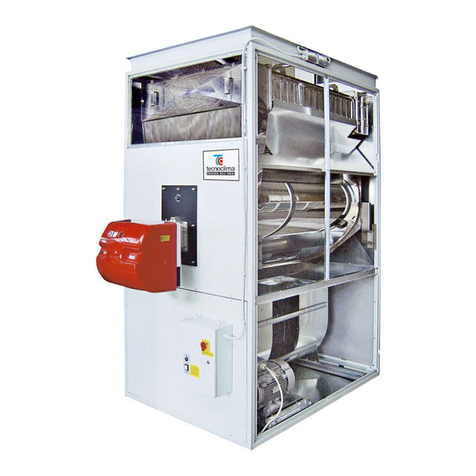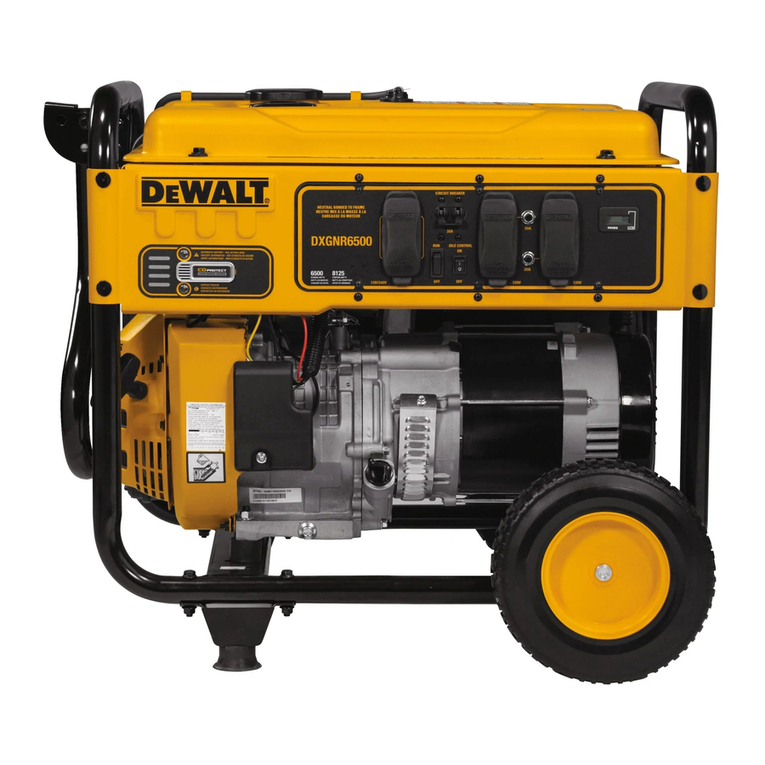Allmand MAXI-POWER 15XR User manual

Operator’s Manual
MAXI-POWER™ 15XR Mobile Generator
Copyright © 2023 Briggs & Stratton
Milwaukee, WI, USA All rights reserved.
Part No.: 118348
Revision: C
en
Manuel d'utilisation
Génératrice mobile MAXI-POWER™ 15XR
Manual del operario
Generador móvil MAXI-POWER™ 15XR
fr
es

2
Products Covered by This
Manual
The following products are covered by this manual:
Maxi-Power™ MP15XR
Manual Contents:
Introduction........................................................................... 2
Safety......................................................................................2
Features And Controls.........................................................6
Pre-Operation Checklist....................................................... 7
Transporting.......................................................................... 8
Operation............................................................................. 13
Maintenance.........................................................................14
Troubleshooting..................................................................17
Specifications......................................................................17
If uncertain about any of the information in the
manual, contact the Allmand service department at
1-800-562-1373, or contact us through the Allmand website,
www.allmand.com.
Save these original instructions for future reference.
Safety
Safety Definitions
For your safety, the safety of others, and to protect the
performance of equipment, follow the precautions listed
throughout the manual before operation, during operation and
during periodic maintenance procedures.
Indicates a potential personal injury hazard.
DANGER
Indicates a hazardous situation which, if not avoided, will
result in death or serious injury.
WARNING
Indicates a hazardous situation which, if not avoided, could
result in death or serious injury.
CAUTION
Indicates a hazardous situation which, if not avoided, could
result in minor or moderate injury.
NOTICE
Information considered important but not hazard related.
Safety Precautions
The following section contains general safety precautions
and guidelines that must be obeyed to reduce risk to
personal safety. Special safety precautions are listed in
specific procedures. Read and understand all of the safety
precautions before operating or performing repairs or
maintenance.
DANGER
Electrocution Hazard
• High voltage is present when engine is running. Never
attempt to service electrical components while engine is
running.
• Do not operate the unit if the insulation on the electrical
cord or other electrical wiring is cut or worn or if bare
wires are exposed. Repair or replace damaged wiring
before starting the engine.
The images throughout this manual are representative, and
may differ from your model.
Any reference in this manual to left or right shall be
determined by looking at the trailer from the rear.
WARNING
Breathing diesel engine exhaust exposes you
to chemicals known to the State of California
to cause cancer and birth defects or other
reproductive harm.
• Always start and operate the engine in a well-
ventilated area.
• If in an enclosed area, vent the exhaust to the
outside.
• Do not modify or tamper with the exhaust
system.
• Do not idle the engine except as necessary.
For more information go to
www.P65Warnings.ca.gov/diesel.
Introduction
About This Manual
TAKE TIME TO READ THIS MANUAL THOROUGHLY
This instruction manual provides necessary instructions for
the Allmand®Maxi-Power™ MP15XR Portable Generator.
The information found in this manual is in effect at the time
of printing. Allmand Bros Inc. may change contents without
notice and without incurring obligation.
....................................................18
Tire Safety Information.......................................................19
Addendum - Unit Options...................................................25
Reporting Safety Defects

3
WARNING
Unsafe Operation Hazard
• Never permit anyone to install or operate the equipment
without proper training.
• Read and understand this Operator’s Manual, the
Engine Operator’s Manual, and any other component
manuals before operating or servicing the equipment
to make sure that safe operating practices and
maintenance procedures are followed.
• Safety signs and decals are additional reminders for
safe operating and maintenance techniques.
WARNING
Fall Hazard
• Never carry riders on the equipment.
WARNING
Modification Hazard
• Never modify the equipment without written consent of
the manufacturer. Any modification could effect the safe
operation of the equipment.
WARNING
Exposure Hazard
• Always wear personal protective equipment, including
appropriate clothing, gloves, work shoes, and eye and
hearing protection, as required by the task at hand.
WARNING
Fire and Explosion Hazard
Batteries give off explosive gases during recharging. Sparks
could cause explosions, resulting in death or serious injury.
Burn Hazard
Batteries contain acid, which is extremely caustic. Contact
with battery contents could cause severe chemical burns.
Shock Hazard
Batteries present a risk of electric shock and high short
circuit current.
• Always disconnect the negative (-) battery cable before
servicing equipment.
• DO NOT dispose of battery in a fire. Recycle battery.
• DO NOT allow any open flame, spark, heat, or lit
cigarette during and for several minutes after charging a
battery.
• DO NOT open or mutilate battery.
• DO NOT charge a frozen battery. Always slowly warm
the battery to room temperature before charging.
• Wear protective gloves, rubber apron, rubber boots and
rubber gloves.
• Remove watches, rings, or other metal objects.
• Use tools having insulated handles.
WARNING
Fire And Explosion Hazard
• Diesel fuel is flammable and explosive under certain
conditions.
• Never use a shop rag to catch fuel.
• Wipe up all spills immediately.
• Never refuel with the engine running.
• Store any containers containing fuel in a well ventilated
area, away from any combustibles or sources of
ignition.
WARNING
Alcohol And Drug Hazard
• Never operate the unit while under the influence of
alcohol or drugs, or when ill.
WARNING
Entanglement / Sever Hazard
• Always stop the engine before beginning service.
• If the engine must be serviced while it is operating,
remove all jewelry, tie back long hair and keep hands,
other body parts and clothing away from moving/
rotating parts.
• Verify that all guards and covers are attached properly
to the equipment before starting the engine. Do not
start the engine if any guards or covers are not properly
installed on the equipment.
• Attach a “Do Not Operate” tag near the key switch while
performing maintenance on the equipment.
WARNING
Flying Object Hazard
• Always wear eye protection when cleaning the
equipment with compressed air or high pressure water.
Dust, flying debris, compressed air, pressurized water
or steam may injure your eyes.
WARNING
Coolant Hazard
• Wear eye protection and rubber gloves when handling
engine coolant. If contact with the eyes or skin should
occur, flush eyes and wash immediately with clean
water.
WARNING
Burn Hazard
• Opening cap on hot radiator could result in death
or serious injury. Allow radiator to cool down before
opening cap.

4
WARNING
Burn Hazard
• Keep hands and other body parts away from hot
surfaces.
• Handle hot components with heat resistant gloves.
NOTICE
• Any part which is found defective as a result of
inspection or any part whose measured value does not
satisfy the standard or limit MUST be replaced.
• Always tighten components to the specified torque.
Loose parts can cause equipment damage or cause it
to operate improperly.
• Follow the guidelines of the Environmental Protection
Agency (EPA), Environment Canada (EC) or other
governmental agencies for the proper disposal of
hazardous materials such as engine oil, diesel fuel and
engine coolant.
• Only use replacement parts specified. Other
replacement parts may effect warranty coverage.
• Clean all accumulated dirt and debris away from the
body of the equipment and its components before
you inspect the equipment or perform preventative
maintenance procedures or repairs. Operating
equipment with accumulated dirt and debris will cause
premature wear of equipment components.
• Never dispose of hazardous materials by dumping them
into a sewer, on the ground, or into groundwater or
waterways.
• Retrieve any tools or parts that may have dropped
inside of the equipment to avoid improper equipment
operation.
• If any alert indicator illuminates during equipment
operation, stop the engine immediately. Determine
the cause and repair the problem before continuing to
operate the equipment.
It is a violation of California Public Resource Code, Section
4442, to use or operate the engine on any forest-covered,
brush-covered, or grass-covered land unless the exhaust
system is equipped with a spark arrester, as defined in
section 4442, maintained in effective working order. Other
states or federal jurisdictions may have similar laws;
reference Federal Regulation 36 CFR Part 261.52.
Safety Decals
Before operating your unit, read and understand the following
safety decals. The cautions, warnings, and instructions are for
your safety. To avoid personal injury or damage to the unit,
understand and follow all the decals.
Keep the decals from becoming dirty or torn, and replace
them if they are lost or damaged. Also, if a part needs to be
replaced that has a decal attached to it, make sure to order
the new part and decal at the same time.
If any safety or instructional decals become worn or
damaged, and cannot be read, order replacement decals
from your dealer.
4
Domestic Models
DANGER - Entering electrical
compartment while equipment
is in operation will result in
death or serious injury. Unplug
equipment before entering electrical
compartment.
Part No. 118074 118074
Machine Grounding Information /
Ground Lug
Part No. 122470
Neutral bonded to frame.
Machine to be grounded in accordance
with requirements as outlined by
local inspection authorities.
Neutre mis à al masse à la carcasse
du moteur.
L'apparel doit etre misa la terre
conformement aux exgences des
services d'inspection locaux.
122470
WARNING - Opening cap on hot
radiator could result in death or
serious injury. Allow radiator to cool
down before opening cap.
Part No. 118651
Opening cap on hot radiator
could result in death or
serious injury.
Allow radiator to cool down
before opening cap.
L’ouverture du bouchon sur
un radiateur chaud pourrait
causer la mort ou des
blessures graves.
Laisser le radiateur refroidir
avant de dévisser le
bouchon.
118651
WARNING - Failure to follow
warnings, instructions and operator’s
manual could result in death or
serious injury. Read and follow
operator’s manual before operating
or servicing this equipment.
Part No. 122467-1
L’omission de respecter
les avertissements, les
instructions et le manuel
de l’utilisateur pourrait
entraîner des blessures
graves ou la mort.
Failure to follow
warnings, instructions,
and operator’s manual
could result in death or
serious injury.
Read and follow
operator’s manual
before operating or
servicing this
equipment.
Lire et suivre le manuel
d’utilisation avant de
faire fonctionner ou de
faire l’entretien de cet
équipement.
WARNING - Unexpected start of
engine could result in death or
serious injury. Read and follow
electronic controller operator’s
manual before operating or servicing
this equipment.
Part No. 122467-2
Le démarrage inattendu
du moteur pourrait
provoquer la mort ou
des blessures graves.
Lire et suivre le manuel
d’utilisation du
contrôleur électronique
avant d’utiliser ou de
réparer cet équipement.
Unexpected start of
engine could result in
death or serious injury.
Read and follow
electronic controller
operator’s manual
before operating or
servicing this equipment.
WARNING - Contact with hot
exhaust gases and parts could
cause death or serious injury. Avoid
hot exhaust gases. Keep hands and
combustible materials away from
hot parts.
Part No. 122467-3
Contact with hot
exhaust gases and
parts could cause
serious injury.
Avoid hot exhaust
gases. Keep hands
and combustible
materials away from
hot parts.
Tout contact avec les
pièces et les gaz
d’échappement
chauds pourrait
causer la mort ou
des blessures
graves.
Éviter les gaz
d’échappement
chauds. Tenir les
mains et les produits
inflammables à
l’écart des pièces
chaudes.
WARNING - Contact with rotating
parts could result in death or serious
injury. Keep away from rotating parts.
Part No. 122467-4
Contact with rotating parts
could result in death or serious
injury.
Keep away from
rotating parts.
Se tenir à l’écart
des pièces en
mouvement.
Le contact avec des pièces en
mouvement pourrait résulter en
de graves blessures voire la
mort.
WARNING - Opening cap on hot
radiator could result in death or
serious injury. Allow radiator to cool
down before opening cap.
Part No. 122467-5
Opening cap on hot
radiator could result in
death or serious injury.
Allow radiator to cool
down before opening
cap.
L’ouverture du bouchon
sur un radiateur chaud
pourrait causer la mort
ou des blessures
graves.
Laisser le radiateur
refroidir avant de
dévisser le bouchon.
WARNING - Exposure to corrosive
materials could cause result in death
or serious injury. Wear protective
gloves when handling battery.
Part No. 122467-6
Exposure to corrosive
material could result in
death or serious injury.
Wear protective gloves
when handling battery.
Toute exposition à des
produits corrosifs
pourrait causer la mort
ou des blessures
graves.
Porter des gants de
protection en
manipulant la batterie.
WARNING - Smoking materials,
open ames, or other forms of
ignition near the battery could
cause explosion resulting in death
or serious injury. Keep smoking
materials, open ames, or other
forms of ignition away from the
battery.
Part No. 122467-7
Smoking materials, open
flames, or other forms of
ignition near the battery could
cause explosion resulting
in death or serious injury.
Les articles de fumeur, les
flammes nues ou d’autres
formes d’allumage près de
la batterie pourraient causer
une explosion, causant la
mort ou des blessures
graves.
Keep smoking materials, open
flames, and other forms of
ignition away from the battery.
Tenir les articles de fumeur, les
flammes nues ou les autres
formes d’allumage à l’écart de
la batterie.
WARNING - Excessive towing speed
could result in death or serious injury.
Do not exceed 65mph (105km/h)
when towing trailer.
Part No. 118108
Excessive towing speed could
result in death or serious injury.
Do not exceed 65mph
(105km/h) when towing trailer.
Une vitesse de remorquage
excessive pourrait entraîner la
mort ou de graves blessures.
Ne pas dépasser 105 km/h
(65 mi/h) lors du remorquage.
118108

en
English 5
Domestic Models
CSA File Number
Part No. 110361
110361
CSA File Number: 204930
For electrical equipment only.
Pour matériel électrique seulement.
WARNING - Failure to follow
warnings, instructions and operator’s
manual could result in death or
serious injury. Read and follow
operator’s manual before operating
or servicing this equipment.
WARNING - Engine exhaust
contains carbon monoxide, a
poisonous gas that could cause
death or serious injury. Run
equipment far from windows, doors
and vents. Do not run equipment
indoors or in partially enclosed
spaces.
WARNING - Breathing diesel engine
exhaust exposes you to chemicals
known to the State of California to
cause cancer and birth defects or
other reproductive harm.
• Always start and operate the
engine in a well-ventilated area.
• If in an enclosed area, vent the
exhaust to the outside.
• Do not modify or tamper with
the exhaust system.
• Do not idle the engine except
as necessary.
www.P65warnings.ca.gov/diesel
Part No. 122985
L’omission de respecter les
avertissements, les instructions
et le manuel de l’utilisateur
pourrait entraîner des blessures
graves ou la mort.
Failure to follow warnings,
instructions, and operator’s
manual could result in
death or serious injury.
Read and follow operator’s
manual before operating or
servicing this equipment.
Lire et suivre le manuel
d’utilisation avant de faire
fonctionner ou de faire
l’entretien de cet équipement.
Engine exhaust contains
carbon monoxide, a
poisonous gas that could
cause death or serious
injury.
Run equipment far from
windows, doors and vents.
Do not run equipment
indoors or in partially
enclosed spaces.
Le moteur contient du monoxyde
de carbone, un gaz toxique
pouvant provoquer la mort ou
de graves blessures.
Faites tourner à l’extérieur, loin
des fenêtres, des portes et des
évents. Ne faites pas fonctionner
à l’intérieur ni dans un espace
partiellement fermé.
• Always start and operate the
engine in a well-ventilated
area.
• If in an enclosed area, vent the
exhaust to the outside.
• Do not modify or tamper with
the exhaust system.
• Do not idle the engine except
as necessary.
www.P65Warnings.ca.gov/diesel.
• Toujours démarrer et faire fonctionner
le moteur dans un endroit bien ventilé.
• Si le moteur est utilisé dans un
espace fermé, ventiler les gaz
d’échappement à l’extérieur.
• Ne pas modifier ni altérer le système
d’échappement.
• Ne pas mettre le moteur au ralenti
sauf en cas de nécessité.
Breathing diesel engine
exhaust exposes you
to chemicals known to
the State of California
to cause cancer and
birth defects or other
reproductive harm.
L’inspiration de gaz
d’échappement du moteur vous
exposeà des produits chimiques
connus selon l’État de Californie
pour causer le cancer, des
anomalies congénitales ou
d’autres effets nuisibles à la
reproduction.
122985
International Models
DANGER - Entering electrical
compartment while equipment
is in operation will result in
death or serious injury. Unplug
equipment before entering electrical
compartment.
Part No. 104880
104880
Ground Lug
Part No. 107969
107969
WARNING - Opening cap on hot
radiator could result in death or
serious injury. Allow radiator to cool
down before opening cap.
Part No. 122091 122091
WARNING - Contact with rotating
parts could result in death or serious
injury. Keep away from rotating parts.
WARNING - Opening cap on hot
radiator could result in death or
serious injury. Allow radiator to cool
down before opening cap.
WARNING - Smoking materials,
open ames, or other forms of
ignition near the battery could
cause explosion resulting in death
or serious injury. Keep smoking
materials, open ames, or other
forms of ignition away from the
battery.
WARNING - Exposure to corrosive
materials could cause result in death
or serious injury. Wear protective
gloves when handling battery.
Part No. 110310
110310
WARNING - Automatic Engine Start.
Unexpected start of engine could
result in death or serious injury.
Read and follow electronic controller
operator’s manual before operating
or servicing this equipment.
Part No. 107978
107978
International Models
WARNING - Excessive towing speed
could result in death or serious injury.
Do not exceed 65mph (105km/h)
when towing trailer.
Part No. 118108
118110
65 mph (105 km/h) max
WARNING - Engine exhaust contains
carbon monoxide, a poisonous gas that
could cause death or serious injury.
Run equipment far from windows,
doors and vents. Do not run equipment
indoors or in partially enclosed spaces.
Part No. 113941
113941
All Models
Tire Information
Part No. 113943
TIRE INFORMATION
SEE OWNER’S
MANUAL FOR
ADDITIONAL
INFORMATION
The weight of cargo should never exceed 0 kg or 0 lbs.
TIRE
FRONT
REAR
SPARE
SIZE
ST 225/75R15D
NONE
NONE
NONE
NONE
448kPa, 65PSI
COLD TIRE PRESSURE
113943
Emergency Stop
Part No. 105567
105567
Operating Instructions
Part No. 118363
1
2
32
1 2
3
1
118363
2
1
1
0° ± 2.8°
1
1 2
32
Electrical Info
Part No. 112130 60 Hz
120/240 V
125/63 A
112130
15 kW
1 Ø
Tie-Down Point
Part No. 109005
109005
Forklift Pocket
Part No. 107254
107254
Oil Drain
Part No. 107973
107973
Fluid Containment Drain
Part No. 107971
107971
Coolant Drain
Part No. 104752
104752
Lift Weight
Part No. 122480
122480
Trailer Serial Number (VIN)
Part No. 119958
Product Operations QR Code
Part No. 123248
123248

6
Engine Preheat Disconnecting
Circuit Breaker
Hourmeter Earth Ground
Trailer Interior
Light
Features And Controls
The Allmand®Maxi-Power™ MP15XR Portable Generator is
intended for use as a stationary generator set.
Identify the features and controls of the machine by
comparing Figures 1 through 3 with the tables following. See
Transporting and Operation for detailed information on each
feature / control.
Front
1
Ref Description
ASafety Chains (2)
BTrailer Coupler / Lunette Ring
CTongue Jack
DLifting Eye
EEngine Compartment Access Door
FGround Lug
GRear Forklift Pocket / Tie Down Point (each side)
HFront Forklift Pocket (each side)
IFront Tie Down Loop
Rear
2
Ref Description
AEngine Compartment Access Door
BBreakaway Kit
CLicense Bracket / Marker Light
DEngine Oil Drain
EFluid Containment Drain
FEngine Coolant Drain
GTail Light (2)
HControl Panel Access Door
IRadiator Access Door
Control Panel
Operation Icons
The following table contains operation icons that may be
found on the unit, along with the meaning of each icon.
Icon Meaning Icon Meaning
Power On Work Light
Power Off Engine Oil Drain
Engine Stop Engine Coolant
Drain
Engine Run Fluid
Containment
Drain
Engine Start Circuit Breaker
6

7
3
Ref Description
AEngine Panel
BAuxiliary Outlet Panel
Pre-Operation Checklist
Perform the following checks before transporting and
operating the unit, as well as when performing general
maintenance.
WARNING
Unsafe Operation Hazard
• Operating or transporting the machine with worn,
damaged or missing parts can result in death or serious
injury. Always replace worn, damaged or missing parts
promptly. Do not transport or operate the machine
until all worn, damaged or missing parts have been
replaced, and proper operation of the machine has
been verified.
Note:
We encourage the use of authorized replacement Allmand
parts. The warranty does not cover damage or performance
problems caused by the use of parts that are not authorized
replacement parts.
1. Check that all safety and operation decals are present
and legible. See Safety - Safety Decals.
2. Check that all operator's manuals (product, engine,
generator, etc.) are with the unit.
3. Check the following components for wear and damage,
and for proper operation:
a. Tongue jack
• Check for rust or damage. Repair or replace as
needed.
• Check for proper operation. See Transporting -
Using The Tongue Jack.
b. Hitch Assembly (trailer coupler / lunette ring)
• Check for rust or damage. Repair or replace as
needed.
• Check for proper operation. See Transporting -
Coupling And Uncoupling The Trailer Hitch.
• Check hardware for proper tightness. Tighten as
needed.
c. Safety chains
• Check for rust or damage. Repair or replace as
needed.
• Check hardware for proper tightness. Tighten as
needed.
d. Trailer lighting cable
• Check for cut, frayed or bare wires. Repair or
replace as needed.
• Check connector for damage. Repair or replace
as needed.
e. Breakaway kit
• Check for broken or frayed wires or breakaway
cable.
• Check battery charge status.
f. Tires
• Check for wear, cuts, cracks, etc. Replace as
needed.
• Check and adjust inflation pressure. See
Specifications for proper inflation pressure.
g. Brakes
• Check brakes for proper operation and wear.
Repair as needed.
h. Axle and undercarriage
• Check for rust or damage. Repair as needed.
i. Electrical wiring
• Check for cut, worn or bare electrical wiring.
Repair as needed.
WARNING
Electrocution hazard
• Operating the unit with cut, worn or bare electrical
wiring could result in death or serious injury. Repair
or replace damaged wiring before operating the light
tower.

8
j. Engine
• Check for leaks or other signs of wear or
damage. Repair as needed.
• Check the air cleaner to be sure it is firmly
attached, and that the air cleaner seals and
hose clamps are properly secured. Check the air
cleaner element. Replace if necessary.
4. Check and adjust fluid levels.
a. Engine Oil
• Refer to the engine operator's manual for oil
recommendations, capacity, and procedures.
NOTICE
Operating engine without oil will cause engine damage.
b. Engine Coolant
• Refer to the engine operator's manual for coolant
recommendations, capacity, and procedures.
NOTICE
Operating engine without coolant will cause engine
damage.
c. Fuel
• See Operation - Fueling The Unit for fuel tank
location, capacity, and fueling procedures.
Transporting
WARNING
Unsafe Operation Hazard
• Operating the equipment without proper training could
result in death or serious injury. Never allow anyone to
operate the equipment without proper training.
Before transporting, readSafety.
Preparing For Work Site Delivery
Prepare the unit for delivery to the work site, especially if it
has been stored or idle for a period of time.
WARNING
Unsafe Operation Hazard
• Operating or transporting a machine with worn,
damaged or missing parts can result in death or serious
injury. Always replace worn, damaged or missing parts
promptly. Do not operate or transport this machine
until all worn, damaged or missing parts have been
replaced, and proper operation of the machine has
been verified.
1. Perform all pre-operation checks. See Pre-Operation
Checklist.
2. Run the engine through a startup and shutdown cycle
to verify operation. See Operation - Operating The
Engine. Also refer to the engine operator's manual.
Preparing For Transport
1. Shut down the engine. See Operation - Operating The
Engine. Also refer to the engine operator's manual
2. Close and lock all access doors.
Towing
Maximum highway speed is 65 mph (105 km/h). Maximum
off-highway speed is 20 mph (32 km/h). Do not exceed these
speed limits.
WARNING
Unsafe Operation Hazard
• Towing the trailer at highway speeds in excess of 65
mph (105 km/h) could result in death or serious injury.
Do not tow the trailer at highway speeds in excess of 65
mph (105 km/h).
Tow vehicle / hitch requirements
1. Check the Gross Vehicle Weight Rating (GVWR) of the
trailer. See Specifications.
2. Check the rated towing capacity of the tow vehicle and
hitch. Both must meet or exceed the GVWR of the trailer.
Note:Check the vehicle owner's manual and hitch owner's
manual for rated towing capacities.
WARNING
Towing Hazard
• Using a tow vehicle or hitch with a rated towing capacity
less than the GVWR of the trailer could result in death
or serious injury. Use only a tow vehicle and hitch with a
rated towing capacity that meets or exceeds the GVWR
of the trailer.
Check the tow vehicle hitch type
The trailer is designed for the following types of available tow
vehicle hitches:
• 2" ball hitch
• Pintle hitch
• 2-5/16" ball hitch
• 2" Bulldog hitch
Be sure the tow vehicle is equipped with either of these hitch
types. Install if needed.
WARNING
Unsafe Operation Hazard
• Failure to use a tow vehicle hitch that mates with the
trailer hitch assembly could result in death or serious
injury. Use only a tow vehicle hitch that mates with the
trailer hitch assembly.

9
Reversing the trailer hitch assembly
The trailer hitch assembly is reversible. Use the trailer coupler
(A, Figure 4) for ball hitches, or the lunette ring (B) for pintle
hitches. To reverse the trailer hitch assembly:
1. Remove the mounting hardware (C, Figure 4).
2. Reverse the trailer hitch assembly.
Note:Use the set of mounting holes in the trailer tongue that
will keep the trailer as level as possible when connected to
the tow vehicle.
3. Reinstall the hardware. Tighten securely.
WARNING
Unsafe Operation Hazard
• Failure to properly install the trailer hitch assembly
could result in death or serious injury. Install the trailer
hitch assembly properly, and tighten the hardware
securely.
4
Connect the trailer to the tow vehicle
1. Position a wheel chock (not supplied) firmly against the
front and rear of the wheel (A, Figure 5) on each side of
the trailer.
5
2. Use the tongue jack to raise the trailer tongue. See
Transporting - Using The Tongue Jack.
3. Position the tow vehicle hitch under the trailer hitch.
4. Couple the trailer hitch to the tow vehicle hitch. See
Transporting - Coupling And Uncoupling The Trailer
Hitch.
5. Connect the safety chains.
WARNING
Unsafe Operation Hazard
• Failure to properly install safety chains could result in
death or serious injury. Always properly install safety
chains.
a. Connect the safety chains (A, Figure 6) to the safety
chain pockets on the tow vehicle. Criss-cross the
chains under the hitch to cradle the hitch in the event
of a disconnect.
b. Rig the chains as tightly as possible while allowing
enough slack to permit free turning.
6. Connect the trailer lighting cable.
a. Make sure the trailer lighting cable mates with the
tow vehicle lighting cable. If needed, install the proper
cable and/or connector to the tow vehicle.
b. Connect the trailer lighting cable to the tow vehicle
lighting cable (B, Figure 6).
c. Make sure there is adequate slack to allow for turning
without allowing the cable to drag on the ground.
d. Check the trailer lights for proper operation.

10
WARNING
Unsafe Operation Hazard
• Failure of trailer lights to operate properly could result
in death or serious injury. Always check for proper
operation of trailer lights, and repair or replace as
needed.
6
7. Retract the tongue jack. See Transporting - Using The
Tongue Jack.
8. Remove the wheel chocks.
The trailer is now ready for towing.
To disconnect the trailer from the tow vehicle
1. Chock the wheels.
2. Deploy the tongue jack. See Transporting - Using The
Tongue Jack.
3. Disconnect the trailer lighting cable from the tow vehicle
lighting cable.
4. Remove the safety chains from the safety chain pockets
on the tow vehicle.
5. Uncouple the trailer hitch from the tow vehicle hitch. See
Transporting - Coupling And Uncoupling The Trailer
Hitch.
6. Move the tow vehicle away from the unit.
Using The Tongue Jack
The unit is equipped with a tongue jack to raise and lower the
trailer tongue, and to level the trailer front-to-rear.
To deploy the tongue jack
1. Remove the jack locking pin (A, Figure 7).
2. Rotate the tongue jack 90° into the operating position (B,
Figure 7). Install the jack locking pin (C).
WARNING
Unsafe Operation Hazard
• Failure to install the jack locking pin could result in
death or serious injury. Be sure the tongue jack is
locked in the operating position with the jack locking
pin.
3. Unfold the jack handle into the operating position (D,
Figure 7).
To lower the jack foot (raise the trailer tongue)
• Turn the jack handle counterclockwise (E, Figure 7) to
lower the jack foot (F) and raise the trailer tongue.
To raise the jack foot (lower the trailer tongue)
• Turn the jack handle clockwise (G, Figure 7) to raise the
jack foot (H) and lower the trailer tongue.
To retract the tongue jack
1. Be sure the trailer is securely supported by the tow
vehicle or other approved means.
WARNING
Unsafe Operation Hazard
• Failure to support the trailer tongue before retracting
the tongue jack could result in death or serious injury.
Be sure the trailer tongue is securely supported before
retracting the tongue jack.
2. Fully raise the jack foot.
3. Fold the jack handle into the transport position (I, Figure
7).
4. Remove the jack locking pin (J, Figure 7).
5. Rotate the tongue jack 90° into the transport position (K,
7). Install the jack locking pin (L).

11
7
Coupling And Uncoupling The Trailer Hitch
Trailer Coupler (for ball hitches)
To couple to the tow vehicle ball hitch
1. Pull up on the locking trigger (A, Figure 8), and lift the
locking lever (B, shown lifted).
2. Use the tongue jack to lower the trailer coupler socket (C,
Figure 8) fully onto the hitch ball (F). See Transporting -
Using The Tongue Jack.
3. Adjust the coupler clamp (D, Figure 8) using the adjusting
nut (E). Tighten the adjusting nut by turning the nut
clockwise, or loosen by turning counter-clockwise. Proper
adjustment is obtained when the coupler is as tight as
possible on the hitch ball and the locking lever can still be
opened and closed.
WARNING
Unsafe Operation Hazard
• Failure to properly adjust the coupler clamp could result
in death or serious injury. Adjust the coupler clamp, and
check adjustment frequently.
4. Push the locking lever down into the locked position.
Insert the locking pin (G, Figure 8) into the hole in the
locking lever, or use a padlock for added security.
5. Check to be sure the coupler is securely attached to the
ball hitch.
To uncouple
1. Remove the locking pin (or padlock, if used) from the hole
in the locking lever.
2. Pull up on the locking trigger, and lift the locking lever.
3. Use the tongue jack to raise the trailer coupler until it
clears the hitch ball. See Transporting - Using The
Tongue Jack.
8
Lunette Ring (for pintle hitches)
To couple to the tow vehicle pintle hitch
1. Open the locking latch (C, Figure 9) on the tow vehicle
pintle hitch (A).
Note:Standard pintle hitch shown; designs vary.
2. Use the tongue jack to lower the lunette ring (B, Figure 9)
into the pintle hitch hook. See Transporting - Using The
Tongue Jack.
3. Close the locking latch. Insert the locking pin (D, Figure 9)
into the hole in the locking latch.
To uncouple
1. Remove the locking pin from the hole in the locking latch.
2. Open the locking latch.
3. Use the tongue jack to raise the lunette ring until it clears
the pintle hitch hook. See Transporting - Using The
Tongue Jack.

12
9
Lifting
Lifting equipment requirements
• Use only approved lifting equipment with a rated lifting
capacity that exceeds the GVWR of the unit. See
Specifications.
WARNING
Unsafe Operation Hazard
• Failure to use approved lifting equipment with a rated
lifting capacity that exceeds the GVWR of the unit could
result in death or serious injury. Use only approved
lifting equipment with a rated lifting capacity that
exceeds the GVWR of the unit.
Lifting points
• Lifting eye - (A, Figure 10) Use only shackles or a locking
type hook when using the lifting eye.
• Forklift pockets - (B, Figure 10) Use forklift blades at least
60" (152 cm) long when lifting the unit. Insert the forklift
blades fully into the forklift pockets.
WARNING
Unsafe Operation Hazard
• Failure to use the designated lifting points to lift the
unit could result in death or serious injury. Use only the
designated lifting points to lift the unit.
WARNING
Crush Hazard
• Standing under or near the unit while it is being lifted
could result in death or serious injury. Never stand
under or near the unit while it is being lifted.
10
Transporting On A Trailer
Three tie-down points, located on the bottom rear of the trailer
(forklift pockets on right and left sides) and the underside of
the trailer tongue (A, Figure 11), are used to secure the unit to
a transport trailer.
Note:All models have similar tie-down point locations.
WARNING
Unsafe Operation Hazard
• Failure to use the designated tie-down points to secure
the unit to the transport trailer could result in death or
serious injury. Always use the designated tie-down
points to secure the unit to the transport trailer.
1. Secure the unit at the tie-down points with appropriately
rated chains or straps.
WARNING
Unsafe Operation Hazard
• Failure to use appropriately rated chains or straps to
secure the unit to the transport trailer could result in
death or serious injury. Always use appropriately rated
chains or straps to secure the unit to the transport
trailer.
2. Do not apply more than 600 lbs (272 kg) force on the
chains or straps.
3. The truck operator is responsible for securing the load
properly to the transport trailer.

13
11
Operation
Before operating, readSafety.
Choosing The Work Site
1. Obey state, province and federal rules and regulations, as
well as rules or instructions for the work site.
2. Consider the following when choosing a work site:
Ground surface
• Set up on smooth, flat, solid ground surfaces only.
• Do not set up on inclines of more than 2.8° (5%
grade) front-to-back and side-to-side.
WARNING
Rollover Hazard
• Setting up the unit on soft or unstable ground, or on
inclines of more than 2.8° (5% grade), could result in
death or serious injury. Set up the unit only on smooth,
flat solid ground surfaces with inclines of no more than
2.8° (5% grade).
Setting Up The Unit
1. Position the unit at the work site. See Operation -
Choosing The Work Site.
2. Chock the wheels. See Transporting – Towing.
3. If the unit was towed to the work site, disconnect from the
tow vehicle. See Transporting – Towing.
4. Level the trailer using the tongue jack. See Transporting
– Using The Tongue Jack.
5. The unit is now set up and ready for operation.
Fueling The Unit
To fuel
• Open the engine compartment access door to access the
fuel tank(s).
• Open the filler cap(s).
• Add fuel as needed. Refer to the engine operator's
manual for fuel recommendations. See Specifications
for fuel capacity.
NOTICE
Diesel fuel only. Use of gasoline could result in engine
damage.
NOTICE
Pressurized fueling is not allowed.
Operating The Unit
Before Operating
1. Perform pre-operation checks. See Pre-Operation
Checklist.
2. Make sure the unit is set up properly at the work site. See
Operation - Setting Up The Unit.
Operating The Engine
To start the engine
Deep Sea models
1. Set the Deep Sea mode switch (C, Figure 12) to ON.
2. See the separate manual for operation of the unit (D,
Figure 12).
12
AInterior Light - Turns on lights inside engine compartment
BDeep Sea Mode Switch
CDeep Sea Unit
To shut down the engine
Deep Sea models
1. See the Deep Sea Manual for Deep Sea shutdown
procedures.
2. Set the Deep Sea mode switch to OFF.
Automatic engine shutdown
The engine is equipped with an automatic engine shutdown
system to prevent excessive engine damage in the event of
low oil pressure or high coolant temperature. For additional
information, refer to the engine operator's manual.
Auxiliary AC Outlets
Units come equipped with a variation of auxiliary AC outlets.
See Figure 13 and the table following.

14
13
A120V GFCI
Outlets
Outlets provide 120V power protected by ground
fault circuit interrupter (GFCI)
BGFCI Reset
Buttons
Resets GFCI Outlets
CAuxiliary
Outlets
Various auxiliary outlets
DAuxiliary Outlet
Breakers
Turns the auxiliary outlets on and off
See Figure 14 and the table following for the types of
available outlets.
14
A20 Amp, 120 Volt 2-Pole, 3-Wire Duplex GFCI NEMA 5-20R
B50 Amp, 120/240 Volt 3-Pole, 4-Wire CS6369 RECEPTACLE
C30 Amp, 120/240 Volt 3-Pole, 4-Wire Twist Lock NEMA L14-30R
D30 Amp, 120 Volt, 2-Pole, 3-Wire NEMA TT-30R
E50 Amp, 120/240 Volt 3-Pole, 4-Wire NEMA L14-50R
Power is supplied to the outlets when the engine is running
and the main breaker is ON.
Each outlet is protected by a dedicated circuit breaker. If a
breaker trips:
1. Disconnect the load from the outlet.
2. Shut off the engine.
3. Wait 10 minutes for the generator to cool down.
4. Correct the load problem.
5. Start the engine.
6. Reset the breaker.
Note:Be sure to also check the GFCI breaker on the GFCI
outlet and reset if necessary.
7. Reconnect the load.
8. If the problem persists, see Troubleshooting.
Shutting Down The Unit
1. Shut down the engine. See Operation - Operating The
Engine.
2. The unit is now ready for transport. See Transporting.
Maintenance
Before performing any maintenance, readSafety.
Scheduled maintenance is necessary for safe and effective
operation of the unit. Under extreme conditions (dusty
conditions, extreme heat or cold, etc.), more frequent
maintenance may be required.
WARNING
Unsafe Operation Hazard
• Operating or transporting a machine with worn,
damaged or missing parts could result in death or
serious injury. Replace worn, damaged or missing
parts promptly. Do not operate or transport the machine
until all worn, damaged or missing parts have been
replaced, and proper operation of the machine has
been verified.
General
Use the pre-operation checklist as a general maintenance
guideline. SeePre-Operation Checklist.
Engine
General Engine Maintenance
Refer to the engine operator's manual for all scheduled
engine maintenance procedures (including oil, coolant, filters,
etc.).
Engine Oil Drain
The unit is equipped with a remote engine oil drain (A, Figure
15).

To drain the engine oil:
1. Place an approved container beneath the oil drain.
2. Remove the oil drain plug or open the oil drain valve,
depending on model.
3. Allow the engine oil to drain completely into the
approved container. Make sure to dispose of used
engine oil according to local, state, province and/or
federal rules.
4. Replace the oil drain plug or close the oil drain valve.
5. Add oil to the engine. Refer to Specications or the
engine operator’s manual for oil recommendations and
capacity.
NOTICE
Failure to add engine oil will result in engine damage.
Engine Coolant Drain
NOTICE
Failure to use the required coolant type (as stated in
the Specications section) in the radiator may result
in damage to the engine and radiator, thus voiding the
warranty.
NOTICE
The mixing of dierent coolant types in the radiator may
result in damage to the engine and radiator, thus voiding
the warranty.
The unit is equipped with a remote engine coolant drain (B,
Figure 15).
To drain the engine coolant:
1. Place an approved container beneath the coolant drain.
2. Remove the coolant drain plug or open the coolant
drain valve, depending on model.
3. Allow the engine coolant to drain completely into the
approved container. Make sure to dispose of used
engine coolant according to local, state, province and/
or federal rules.
4. Replace the coolant drain plug or close the coolant
drain valve.
5. Open the coolant ll access door (C, Figure 15), and
add coolant to the engine. Refer to Specications.
NOTICE
Failure to add engine coolant will result in engine damage.
15
C
B
A
Electrical System
Generator
Refer to the Generator Operator’s Manual for all scheduled
generator maintenance procedures.
Trailer
Frame
1. Check the trailer coupler for proper operation, and for
corrosion or damage. Replace as needed.
2. Inspect the trailer frame and body panels for rust, nicks
and chips. Use the proper touch-up paint to touch up
nicks or scratches. Contact your dealer for additional
information.
3. Inspect the axle, springs and undercarriage for wear
and damage. Replace as needed.
4. Inspect the tongue jack for proper operation, and
for wear, damage or corrosion. Repair or replace as
needed.
5. Inspect the safety chains for wear and corrosion
damage. Replace as needed.
6. Check the breakaway kit for damage. Check that the
battery is properly charged. Check the wiring for wear
or fraying. Inspect the breakaway cable for wear or
damage. Repair or replace as needed.
Grease Points
1. Use NGLI consistency #2 high-temperature anti-friction
bearing lubricating grease for all trailer mechanical
pivot points.
Trailer Wheels and Tires
WARNING
Towing Hazard
Towing a trailer with damaged tires, rims or lug nuts could
result in death or serious injury. Never tow the trailer with
damaged tires, rims or lug nuts.
1. Check the tires for any cracks, cuts or damage. Repair
or replace the damaged tires before towing.
2. Check the air pressure of the trailer tires when cold.
See Specications.
3. Check the wheel rims for any cracks or damage.
4. Check the brakes to make sure that they work properly.
5. Make sure all the lug nuts are in place. Never tow the
trailer with missing or improperly tightened lug nuts.
6. Check that the lug nuts are tightened properly. The
correct torque for the lug nuts is 90 lb-ft (122 Nm).
7. When torquing lug nuts, always use a criss-cross
pattern (Figure 16).
en
English 15

16
16
Wheel Bearings
Refer to the axle manual for information regarding
maintenance of wheel bearings and other axle components.
Trailer Lighting
WARNING
Towing Hazard
• Never tow the trailer with inoperable trailer lights. Lights
are a vital safety feature of your trailer and are also
required by state law. Keep the lights in proper working
order.
1. Check the trailer lights and harness for damage or wear.
Repair or replace as needed.
2. Make sure the harness is secured to the trailer and does
not hang down onto the ground.
3. Check the taillight housing assemblies for damage or
leaks. Use silicone or rubber sealant to seal the lens or
harness, as required, or replace the housing assembly.
Electrical grease will help protect the sockets and prevent
corrosion.
4. When replacing bulbs, make sure the proper bulb is
used and use a small amount of electrical grease in the
sockets to prevent corrosion.
5. For trailer wiring schematic information, refer to the
separate Wire Schematic Manual.
Cleaning
WARNING
Entanglement Hazard
Failure to shut down the engine before cleaning the unit
could result in death or serious injury. Always shut down the
engine before cleaning the unit.
WARNING
Burn Hazard
Shut down the engine and allow ample time for components
to cool before cleaning the unit. Failure to do so could result
in serious burns.
NOTICE
Use caution when using compressed air or water / steam
pressure washers. Do not pressure–clean electrical
components, as this may cause damage.
Keeping the unit clean is important to ensure proper
operation. Dirt and dust buildup acts as an insulator and may
cause the engine and generator to operate at excessively
high temperatures.
Use the following as cleaning guidelines:
1. Clean the trailer to remove all dust, dirt or other foreign
material.
2. Clean all electrical wiring and components by hand using
non-corrosive cleaner.
3. Clean the inside of the engine compartment.
4. Clean any oil or liquid spills inside the engine
compartment.
5. Empty the fluid containment tray. See Draining the Fluid
Containment Tray.
Fluid Containment System
The unit contains a fluid containment system designed to
catch fuel, oil or coolant spills. To drain:
1. Position a suitable container beneath the fluid
containment drain (A, Figure17)
2. Remove the drain plug.
3. Allow the fluid to drain completely into the container.
4. Reinstall the drain plug.
5. Dispose of the fluid properly in accordance with
governmental guidelines.
17

17
Long-Term Storage
Proper maintenance is required when the unit will be stored
or removed from operation for long periods of time.
Refer to the Engine Operator's Manual and the Generator
Operator's Manual for all engine and generator long-term
storage procedures.
1. Make any repairs necessary to make sure the equipment
is fully functional upon recommissioning.
2. Clean and wash the frame and body panels. Apply an
anti-corrosion coating to all surfaces where applicable.
3. Clean any oil or liquid spills inside the engine
compartment.
4. Drain the fluid containment system.
5. Clean all electrical wiring and components by hand using
non-corrosive cleaner.
6. Disconnect and remove the battery.
7. Use a suitable cover to protect the unit.
8. Properly support the trailer axle on jack stands or other
suitable supports to allow the tires to remain off the
ground during storage.
Models and Serial Numbers
Model and serial number information is required for product
support and repair parts. Following are the model and serial
number locations of the primary components.
Trailer
The serial number plate for the trailer is located on the left
front side of the unit (A, Figure 18).
18
Generator
The generator has a serial number plate (A, Figure 19)
attached to the side of the housing.
19
Engine
The engine has a serial number plate (A, Figure 20) attached
near the top of the engine.
20
Troubleshooting
Before performing any troubleshooting procedures, read
Safety.
For engine and generator troubleshooting, refer to the Engine
Operator's Manual and Generator Operator's Manual, or
contact your dealer.
For all other issues, contact your dealer.
Specifications
Overall Dimensions
Dimension Imperial Metric
Length 10 ft - 6 in 3,20 m
Width 6 ft - 5 in 1,96 m
Height 6 ft - 2 in 1,86 m
Bottom Clearance 8.5 in 216 mm

18
Shipping Weight 2500 lbs 1134 kg
Gross Vehicle Weight
Rating (GVWR)
5000 lbs 2267 kg
Trailer
Specification Imperial Metric
Gross Axle Weight
Rating (GAWR)
5000 lbs 2267 kg
Tire Size and Rating ST225/75R15D Load Range 'D'
Rims 15 x 6 JJ
Cold Tire Inflation
Pressure
65 psi 448 kPa
Max. On-Road Speed 65 mph 105 km/h
Max Off-Road Speed 20 mph 32 km/h
Fuel Tank 100 US Gallons 378 L
Frame Structure Formed welded steel design
Axle Tubular design
Hubs (6) 1/2-20 UNF studs on a 5.5 inch (139,7 mm)
bolt circle
Springs Elliptical springs - 3 Leafs
Trailer Road Lighting Stop, turn, tail, side markers, illuminated license
plate bracket
Trailer Road Light
Connector
7-Way RV Connector
Lifting Eye - Rated
Capacity
5000 lbs 2267 kg
Tie-Down Points 2 tie-down slots in rear forklift pocket tube, and 2
tie-down slots at front forklift pocket tube
Forklift Pockets 2 each side
Electrical - AC Power
Frequency 60 Hz
Rated Prime Power Output with
Perkins 1.5T Engine
15.0 kW
Alternator 120 / 240 VAC Automatic Voltage
Regulator (AVR)
Phases 1-phase
Engine - General Service Information
PERKINS TURBO C1.5T
Specification Imperial Metric
Model Perkins C1.5T
Type Water-cooled 3-cylinder diesel
Displacement 91 cu. in. 1491 cc
Aspiration Turbo-charged
Emissions EPA Tier 4 Final / EU Stage IV
Power Output - Prime 22.3 Hp @1800 rpm 16,6 kWm @1800 rpm
Fuel System Indirect injection
Starting Aid Glow plug
Engine Alternator 60 A
Automatic Low Oil
Pressure Shutdown
10 psi 69 kPa
Automatic High Water
Temperature Shutdown
234° F 112° C
Fuel North America - diesel fuels that meet ASTM
D975 for Ultra Low Sulfur Diesel (ULSD) are
required. ULSD has a maximum sulfur content
of 15 parts per million (PPM) or 15 mg/kg. Diesel
fuel may be No. 1-D or No. 2-D. Refer to Engine
Operator’s Manual for detailed information.
Engine Oil Refer to Engine Operator’s Manual for detailed
information.
Engine Oil Capacity -
with Filter
7.5 US qts 7,0 L
Coolant System
Capacity
6.5 US qts 6,1 L
Coolant Overflow
Reservoir Capacity
1.1 US qts 1,0 L
Service Interval - Fuel
Filter
500 hours
Service Interval - Oil
Change and Filter
500 hours
Electrical - DC Power
Number of batteries 1-2
Battery Size Group 24
Battery Type Standard - Lead Acid
Optional - Absorbed Glass Mat
(AGM)
Battery Rating Standard - 525 CCA @ 0° F (-18° C)
Optional - 775 CCA @ 0° F (-18° C)
Engine Electrical System 12 Volt DC
Component Manuals
In addition to this Operator's Manual, be sure to read
any component manuals that are included with the machine.
For models equipped with Dexter axle, the operator's
manuals can be found online at: http://www.dexteraxle.com/
resources/manuals.
For electric brake maintenance, choose Light Duty Electric
Brake.
For hubs, drums, and bearings maintenance, choose Light
Duty Hubs Drums and Bearings.
For maintenance schedule, choose Light Duty Maintenance
Schedule.
Fuel
North America - diesel fuels that meet
ASTM D975 for Ultra Low Sulfur
Diesel (ULSD) are required. ULSD
has a maximum sulfur content of 15
parts per million (PPM) or 15 mg/
kg. Diesel fuel may be No. 1-D or
No. 2-D. Refer to Engine Operator’s
Manual for detailed information.
Required Engine Oil Type Refer to Engine Operator’s Manual
for detailed information.
Engine Oil Capacity - with Filter 7.5 US qts 7,0 L
Coolant System Capacity 6.5 US qts 6,1 L
Required Engine Coolant Type
Nitrite Free Extended Life Coolant,
Organic Acid Technology (OAT),
2-EHA Free
Coolant Overow Reservoir
Capacity 1.1 US qts 1,0 L
Service Interval - Oil Change &
Filter 500 hr
Service Interval - Fuel Filter 500 hrs
Service Interval - Air Filter Refer to Engine Op Manual
Note* Engine oil must be checked prior to
operation and relled if necessary
Electrical - DC Power
Engine Electrical System 12 Volt DC
Number of Batteries 1-2
Battery Size Group 24
Battery Type
Standard - Lead Acid
Optional - Absorbed Glass Mat
(AGM)
Battery Rating 525 CCA @ 0°F (-18°C)
775 CCA @ 0°F (-18°C)
Component Manuals
In addition to this Operator’s Manual, be sure to read any
component manuals that are included with the machine.
For models equipped with Dexter axle, the operator’s
manuals can be found online at: http://www.dexteraxle.com/
resources/manuals.
For electric brake maintenance, choose Light Duty Electric
Brake.
For hubs, drums, and bearings maintenance, choose Light
Duty Hubs Drums and Bearings.
For maintenance schedule, choose Light Duty Maintenance
Schedule.
18
Reporting Safety Defects
Reporting Safety Defects to the United States
Government
If you believe that your vehicle has a defect which could
cause a crash or could cause injury or death, you should
immediately inform the National Highway Trac Safety
Administration (NHTSA) in addition to notifying Allmand.
If NHTSA receives similar complaints, it may open an
investigation, and if it nds that a safety defect exists
in a group of vehicles, it may order a recall and remedy
campaign. However, NHTSA cannot become involved in
individual problems between you, your dealer, or Allmand.

en
English 19
To contact NHTSA, you may call the Vehicle Safety Hotline
toll-free at 1-888-327-4236 (TTY: 1-800-424-9153); go to
http:// www.safercar.gov; or write to: Administrator, NHTSA,
400 Seventh Street, SW., Washington, DC 20590.
You can also obtain other information about motor vehicle
safety from http://www.safercar.gov.
Reporting Safety Defects to the Canadian
Government
If you live in Canada, and you believe that the vehicle has
a safety defect, notify Transport Canada immediately, and
notify Allmand. Call Transport Canada at 1-800-333-0510;
go to: www.tc.gc.ca/recalls (English) www.tc.gc.ca/rappels
(French); or write to: Transport Canada Motor Vehicle
Safety Directorate Defect Investigations and Recalls
Division, 80 Noel Street, Gatineau, QC J8Z 0A1
Reporting Safety Defects to Allmand
In addition to notifying NHTSA (or Transport Canada) in
a situation like this, notify Allmand. Contact the Allmand
service department at 1-800-562-1373, go to www.allmand.
com, or write to: Allmand Bros., Inc.P.O. Box 888 Holdrege,
NE 68949.
Tire Safety Information
The following section contains tire safety information as
required by 49 CFR 575.6. It will cover the following:
(i) Tire labeling, including a description and explanation
of each marking on the tires provided with the vehicle,
and information about the location of the Tire Identication
Number (TIN);
(ii) Recommended tire ination pressure, including a
description and explanation of:
(A) Recommended cold tire ination pressure,
(B) The vehicle placard and tire ination pressure label
and their location in the vehicle
(C) Adverse safety consequences of underination
(including tire failure), and
(D) Measuring and adjusting air pressure to achieve
proper ination;
(iii) Glossary of tire terminology, including ‘‘cold
tire pressure,’’ ‘‘maximum ination pressure,’’ and
‘‘recommended ination pressure,’’ and other non-technical
terms;
(iv) Tire care, including maintenance and safety practices;
(v) Vehicle load limits, including a description and
explanation of:
(A) Locating and understanding load limit information,
total load capacity, seating capacity, towing capacity, and
cargo capacity,
(B) Calculating total and cargo load capacities with
varying seating congurations including quantitative
examples showing/illustrating how the vehicle’s cargo and
luggage capacity decreases as the combined number and
size of occupants increases,
(C) Determining compatibility of tire and vehicle load
capabilities,
(D) Adverse safety consequences of overloading on
handling and stopping and on tires.
1. Steps for Determining Correct Load Limit—
Trailer
Determining the load limits of a trailer includes more than
understanding the load limits of the tires alone. On all
trailers there is a Federal certication / VIN label that is
located on the forward half of the left (road) side of the unit.
This certication / VIN label will indicate the trailer’s Gross
Vehicle Weight Rating (GVWR). This is the most weight the
fully loaded trailer can weigh. It will also provide the Gross
Axle Weight Rating (GAWR). This is the most a particular
axle can weigh. If there are multiple axles, the GAWR of
each axle will be provided.
If your trailer has a GVWR of 10,000 pounds or less,
thereis a vehicle placard located in the same location
as the certication label described above. This placard
provides tire and loading information. In addition, this
placard will show a statement regarding maximum cargo
capacity. Cargo can be added to the trailer, up to the
maximum weight specied on the placard. The combined
weight of the cargo is provided as a single number. In any
case, remember: the total weight of a fully loaded trailer
can not exceed the stated GVWR.
For trailers with living quarters installed, the weight of water
and propane also need to be considered. The weight of
fully lled propane containers is considered part of the
weight of the trailer before it is loaded with cargo, and is
not considered part of the disposable cargo load. Water
however, is a disposable cargo weight and is treated as
such. If there is a fresh water storage tank of 100 gallons,
this tank when lled would weigh about 800 pounds. If
more cargo is being transported, water can be o-loaded to
keep the total amount of cargo added to the vehicle within
the limits of the GVWR so as not to overload the vehicle.
Understanding this exibility will allow you, the owner, to
make choices that t your travel needs.
When loading your cargo, be sure it is distributed evenly
to prevent overloading front to back and side to side.
Heavy items should be placed low and as close to the axle
positions as reasonable. Too many items on one side may
overload a tire. The best way to know the actual weight
of the vehicle is to weigh it at a public scale. Talk to your
dealer to discuss the weighing methods needed to capture
the various weights related to the trailer. This would include
the weight empty or unloaded, weights per axle, wheel,
hitch or king-pin, and total weight.
Excessive loads and / or underination cause tire
overloading and, as a result, abnormal tire exing occurs.
This situation can generate an excessive amount of heat
within the tire. Excessive heat may lead to tire failure. It
is the air pressure that enables a tire to support the load,
so proper ination is critical. The proper air pressure may
be found on the certication / VIN label and/or on the Tire
Placard. This value should never exceed the maximum cold
ination pressure stamped on the tire.

20
1.1 Trailers 10,000 Pounds (4536 kg) GVWR or less
(1) Locate the statement “The weight of cargo should
never exceed XXX kg or XXX lbs.” on your vehicle’s
placard.
(2) This gure equals the available amount of cargo and
luggage load capacity.
(3) Determine the combined weight of luggage and cargo
being loaded on the vehicle. That weight may not safely
exceed the available cargo and luggage load capacity.
1.2 Trailers over 10,000 Pounds (4536 kg) GVWR
(Note: These trailers are not required to have a tire
information placard on the vehicle.)
(1) Determine the empty weight of your trailer by weighing
the trailer using a public scale or other means. This step
does not have to be repeated.
(2) Locate the GWVR of the trailer on your trailer’s VIN
(Certication) label.
(3) Subtract the empty weight of your trailer from the
GVWR stated on the VIN label. That weight is the
maximum available cargo capacity of the trailer and may
not be safety exceeded.
2. Steps for Determining Correct Load Limit—
Tow Vehicle
(1) Locate the statement “The combined weight of
occupants and cargo should never exceed XXX kg or XXX
lbs.” on your vehicle’s placard.
(2) Determine the combined weight of the driver and
passengers that will be riding in your vehicle.
(3) Subtract the combined weight of the driver and
passengers from XXX kg or XXX lbs.
(4) The resulting gure equals the available amount of
cargo and luggage load capacity. For example, if the ‘‘XXX’’
amount equals 1400 lbs. and there will be ve 150 lb
passengers in your vehicle, the amount of available cargo
and luggage load capacity is 650 lbs. (1400–750 (5 × 150)
= 650 lbs.)
(5) Determine the combined weight of luggage and cargo
being loaded on the vehicle. That weight may not safely
exceed the available cargo and luggage load capacity
calculated in Step 4.
(6) If your vehicle will be towing a trailer, load from your
trailer will be transferred to your vehicle. Consult the
tow vehicle’s manual to determine how this reduces the
available cargo and luggage load capacity of your vehicle.
3.Glossary of Tire Terminology
Accessory weight means the combined weight (in
excess of those standard items which may be replaced)
of automatic transmission, power steering, power brakes,
power windows, power seats, radio, and heater, to the
extent that these items are available as factory-installed
equipment (whether installed or not).
Bead means the part of the tire that is made of steel wires,
wrapped or reinforced by ply cords and that is shaped to t
the rim.
Bead separation means a breakdown of the bond between
components in the bead.
Bias ply tire means a pneumatic tire in which the ply
cords that extend to the beads are laid at alternate angles
substantially less than 90 degrees to the centerline of the
tread.
Carcass means the tire structure, except tread and
sidewall rubber which, when inated, bears the load.
Chunking means the breaking away of pieces of the tread
or sidewall.
Cord means the strands forming the plies in the tire.
Cord separation means the parting of cords from adjacent
rubber compounds.
Cracking means any parting within the tread, sidewall, or
inner liner of the tire extending to cord material.
Curb weight means the weight of a motor vehicle with
standard equipment including the maximum capacity of
fuel, oil, and coolant, and, if so equipped, air conditioning
and additional weight optional engine.
Cold ination pressure means the tire pressure when the
vehicle hasn’t been driven for at least three hours.
Extra load tire means a tire designed to operate at higher
loads and higher ination pressure than the corresponding
standard tire.
Groove means the space between two adjacent tread ribs.
Gross Axle Weight Rating or GAWR means the value
specied by the vehicle manufacturer as the load-carrying
capacity of a single axle system, as measured at the tire-
ground interfaces.
Gross vehicle weight rating or GVWR means the value
specied by the manufacturer as the loaded weight of a
single vehicle.
Hitch Weight means the downward force exerted on the
hitch ball by the trailer coupler.
Innerliner means the layer(s) forming the inside surface of
a tubeless tire that contains the inating medium within the
tire.
Innerliner separation means the parting of the innerliner
from cord material in the carcass.
Light truck (LT) tire means a tire designated by its
manufacturer as primarily intended for use on lightweight
trucks or multipurpose passenger vehicles.
Load rating means the maximum load that a tire is rated to
carry for a given ination pressure.
Maximum load rating means the load rating for a tire at
the maximum permissible ination pressure for that tire.
Maximum permissible ination pressure means the
maximum cold ination pressure to which a tire may be
inated.
Maximum loaded vehicle weight means the sum of — (a)
Curb weight; (b) Accessory weight; (c) Vehicle capacity
weight; and (d) Production options weight.
Measuring rim means the rim on which a tire is tted for
physical dimension requirements.
This manual suits for next models
1
Table of contents
Languages:
Other Allmand Portable Generator manuals
Popular Portable Generator manuals by other brands

Tektronix
Tektronix RTX130A user manual

Chicago Electric
Chicago Electric 97906 Set up, operating, and servicing instructions
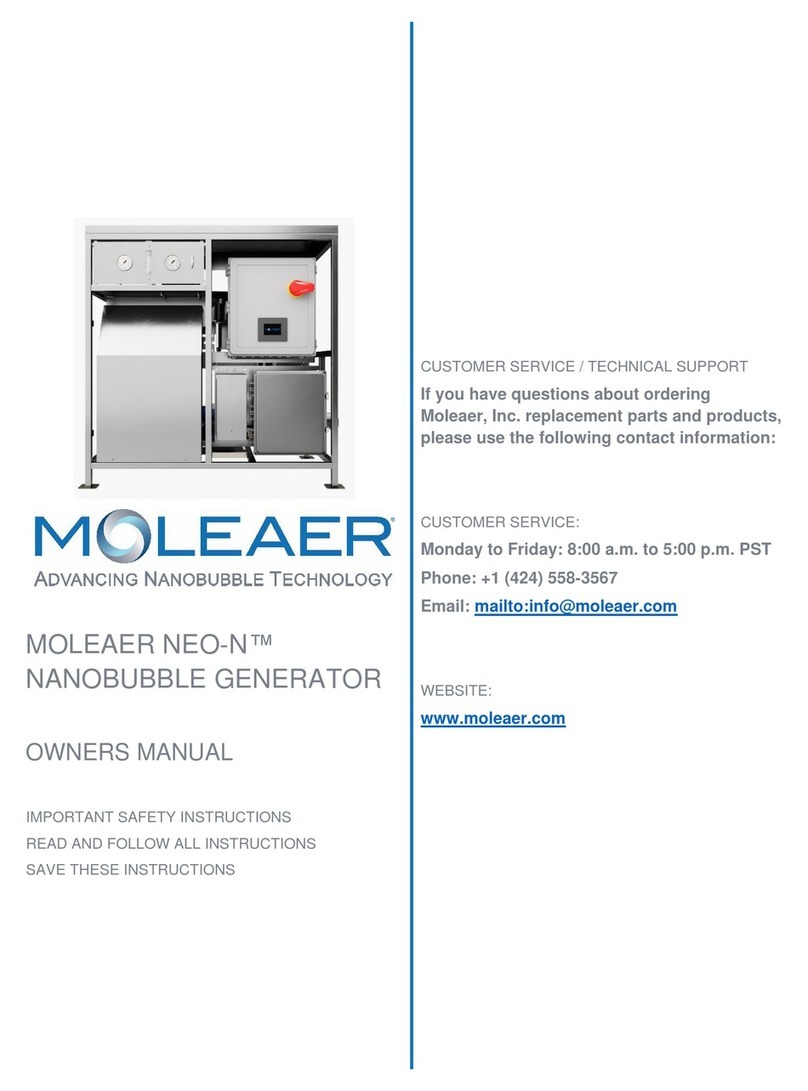
MOLEAER
MOLEAER NEO-N S2 owner's manual
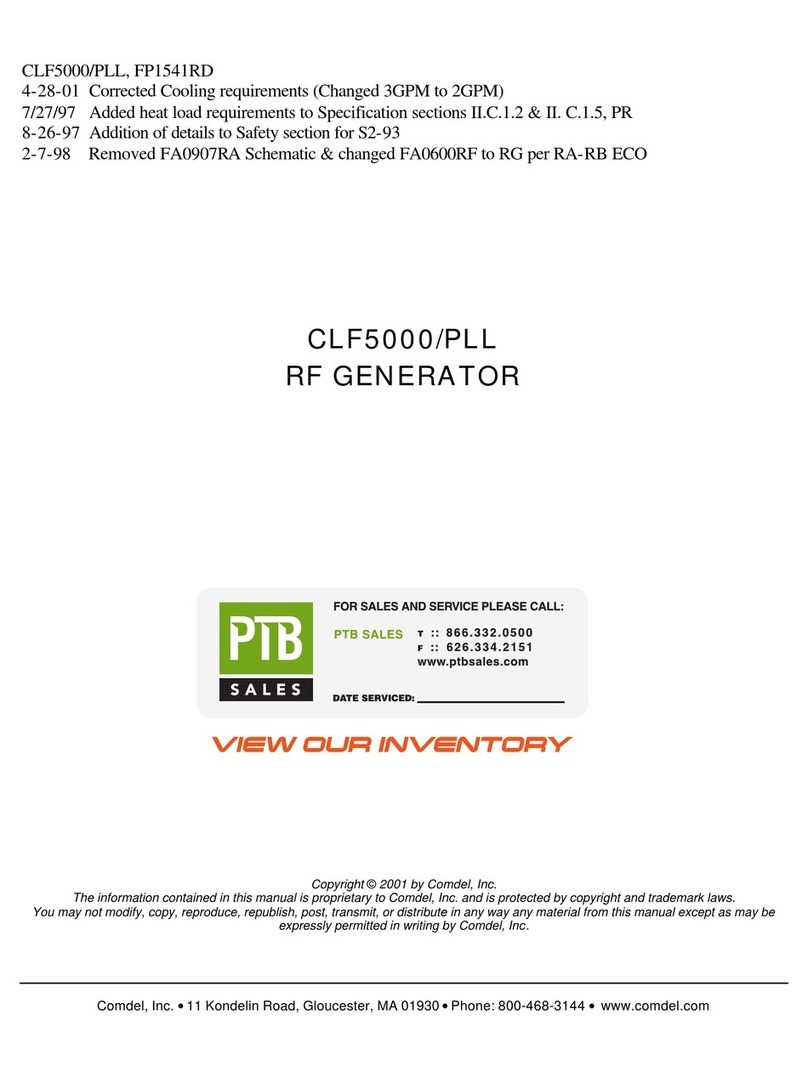
Comdel
Comdel CLF5000/PLL manual
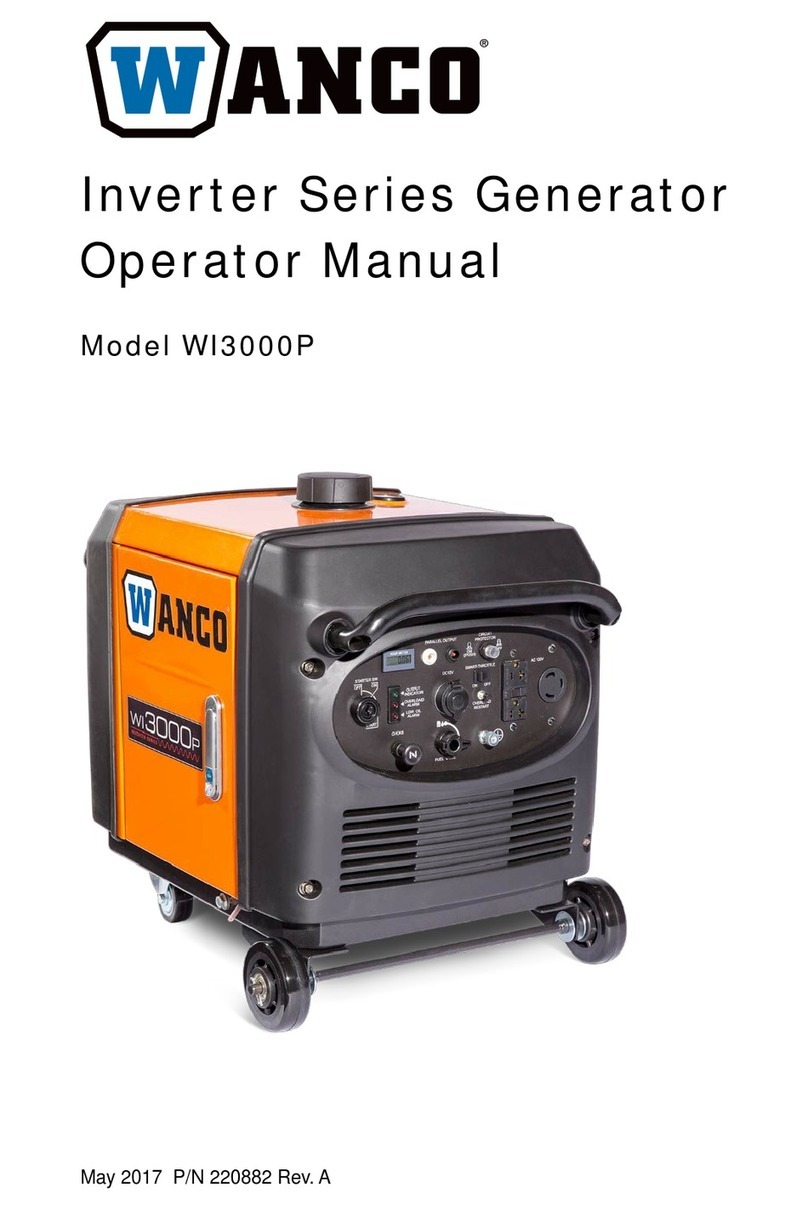
Wanco
Wanco WI3000P Operator's manual

Champion Global Power Equipment
Champion Global Power Equipment aXis installation manual
